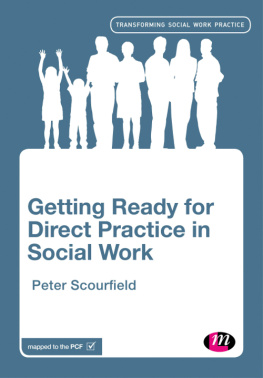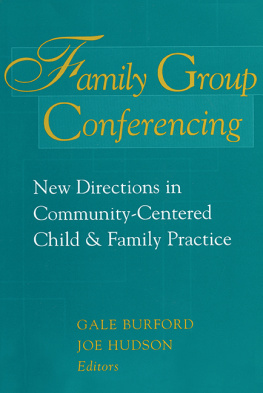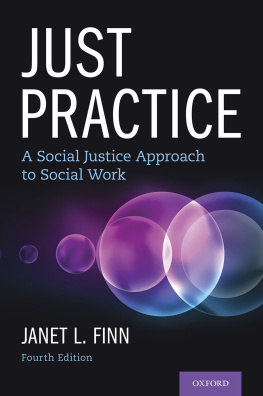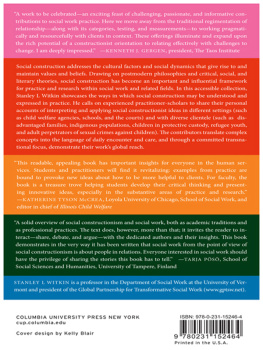
COLUMBIA UNIVERSITY PRESS
Publishers Since 1893 New York Chichester, West Sussex
cup.columbia.edu
Copyright 2006 Columbia University Press
All rights reserved
E-ISBN 978-0-231-50782-0
Library of Congress Cataloging-in-Publication Data
Wood, Gale Goldberg.
The structural approach to direct practice in social work: a social constructionist perspective / Gale Goldberg Wood and Carol T. Tully.3rd ed.
p. cm.
Includes bibliographical references and index.
ISBN 0231132840 (alk. paper)
1. Social service. 2. Social serviceUnited States. 3. Social workers. 4. Social workersUnited States. I. Tully, Carol Thorpe, 1946 II. Title.
HV40.W66 2006
361.32dc22 2006006271
A Columbia University Press E-book. CUP would be pleased to hear about your reading experience with this e-book at .
THE CRAFT OF BOOK WRITING is an arduous one that takes tenacity and a good sense of humor. As with any adventure, many people are involved, all of whom are deserving of our thanks. We are indebted to those who helped with the actual production of the text.
First, thanks must go to John Michel at Columbia University Press, who insisted that a new edition of this book was needed. Sadly, he made his transition from this life before this edition was completed. Shelley Reinhardt, our editor at Columbia University Press, guided us through the quagmire of regulations and, although new, did a fine job. Gregory McNamee, our copyeditor, is a special guy with a good heart and a sharp blue pencil. His edits were extremely helpful, since we both have trouble knowing where commas actually belong.
We deeply value the suggestions, involvement, and willingness to help make this book better of those who read and responded to the manuscript draft, Susan Roche and Richard L. Edwards. We especially want to recognize Susan for her enormously helpful comments on our first draft.
Laura Gibson and Peggy McGuire computerized many of the figures from which the final versions were derived, and they both deserve no small amount of thanks for all their work. Both, we believe, now have a better understanding of how demanding the creation of a text is.
Finally, we thank our students. You may have no idea what a profound impact you have on us and on our writing.
G ALE G OLDBERG W OOD AND C AROL T. T ULLY
Creating the structural approach and continuing to develop it have been part of my life for more than thirty years, and I am enormously pleased that this book has survived the test of time. Sadly, Ruth R. Middleman, my longtime friend and writing partner, was not able to participate in this, the most extensive shift in the theorys evolution to a postmodern, social constructionist epistemology. Ruths health was rapidly declining, and she died almost a year before the book went to press. I still miss her.
I would like to thank Carol Tully for her willingness to learn a new set of ideas and adopt a new perspective on old ones in order to tackle the new thinking with me that the radically revisioned practice described in this edition required. I needed someone to challenge my thinking so I would not be limited by the boundaries of my own mind. We wrote this together and often jointly rewrote portions line by line.
I also want to thank my sweet husband David for supporting me throughout this process and reminding me that there is more to life than this text.
G ALE G OLDBERG W OOD
Although I have written and edited other books, reworking an existing text that has long been a classic in social work education was a new adventure for me. To my coauthor, Gale Goldberg Wood, who was gracious in letting me work with her on the revisions, I owe a huge debt. We chewed on words, discussed syntax, laughed at ourselves, and through it all never had an argument. Although I never met Ruth Middleman, her work is evident across the text, and I thank her for helping to make this book the classic it has become. She did not live to see the completion of this new edition, but I hope she would have been pleased.
I thank all those who helped keep me smiling as I wrote and rewrote. My partner, Jean Walker, deserves special recognition. She helped maintain everything in proper perspective by keeping me centered on the present moment. She is a constant reminder of the good in everyone. An especially warm thanks to David Wood, who knows that the path to greatness is through food. His lunches were always appreciated. As this book goes to press, many of my friends in New Orleans are still struggling with the aftermath of Hurricane Katrina. I thank them for helping me realize what is important.
C AROL T. T ULLY
ALTHOUGH REALITY IS socially constructed and socially reproduced, the forces these social constructions generate and the institutional acts they spawn are real. Poverty is real, a function of a social construction, capitalism. A larger percentage of people of color are poor, a function of socially constructed racism. Violence against womenbattering, rape, sexual harassmentis real, a function of patriarchy. The relationships in each instance are power relations; that is to say, they are political.
In most instances, those who benefit from the oppression of others are hidden from ordinary scrutiny, as are the dynamics of power and the connections of the personal to the political. Social constructionism and deconstruction can help us understand the roots of these problems and unmask the power dynamics involved in creating and sustaining them, but it takes political action to contest them and their consequences.
This third edition of the book attempts to apply both ideasthe social construction of reality and the political realities that social constructions generate. The structural practice principles now include one that is explicitly devoted to the deconstruction of taken-for-granted social discourse, as well as a chapter on narrative therapy and the role of the therapist. Deconstruction and narrative practice fit nicely within a direct practice model geared toward meeting social need through social change, promoting social justice, alleviating oppression, and increasing peoples options in life. An additional chapter to guide grassroots community organizing also bolsters the practitioners ability to help clients confront the oppressive political realities created by reification of social constructions.













